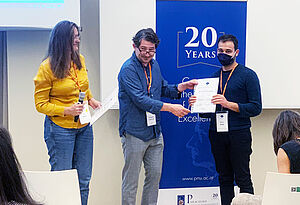![[Translate to English:] Adrian Klepe gewinnt Posterpreis auf dem Joint ASEV/GSEV Meeting](/fileadmin/_processed_/5/8/csm_HB_HMD_AdrianKlepe-Posterpreis2022_DE_1200x675_f240f90a39.jpg)
The group of AIT blood-brain barrier expert Winfried Neuhaus, Competence Unit Molecular Diagnostics of the AIT Center for Health and Bioresources, is researching the interactions of extracellular vesicles with the blood-brain barrier. The data was collected as part of the FWF Exo-BBB project and has now been awarded a prize.
Small extracellular vesicles (sEVs) are released by cells in response to changing environmental conditions in order to communicate with neighbouring cells or even more distant organs. The small spheres (100 nm in diameter) are delimited by a lipid bilayer, like mammalian cells, and carry within them many molecules such as miRNA, mRNA and proteins that can trigger reactions in cells they come into contact with. Adrián Klepe, PhD student in the Biological Barriers Group, presented data from the research at the joint meeting of the Austrian and German Societies for Extracellular Vesicles (ASEV and GSEV) at Paracelsus Medical University in Salzburg on 28-29 October. Together with Adrián, Ana Špilak also contributed to the core of the poster "Interaction and transport of small extracellular vesicles across human blood-brain barrier in vitro models", which focused on the uptake, permeation and interaction of sEV from cancer and non-cancer cells with two different models of the blood-brain barrier (BBB). It highlighted the importance of essential sEV-specific controls and sEV permeation results after optimising the conditions for these in vitro studies. The EV-community awarded Adrián, his 2-minute pitch and the poster with the "Best Poster Award", which not only brought recognition from the Austrian and German EV societies, but also prize money of €500. The other co-authors and supervisors Sophia Theresa Kriwanek, Andreas Brachner, Christa Noehammer and Winfried Neuhaus were also delighted with the unexpected success. Future results could help to better understand how sEVs interact with and cross the endothelial cells of the brain, which could ultimately lead to an improved availability of drugs for diseases in the brain.



